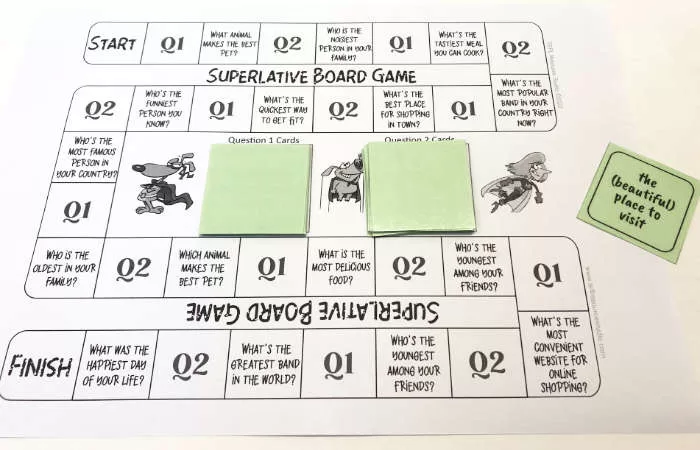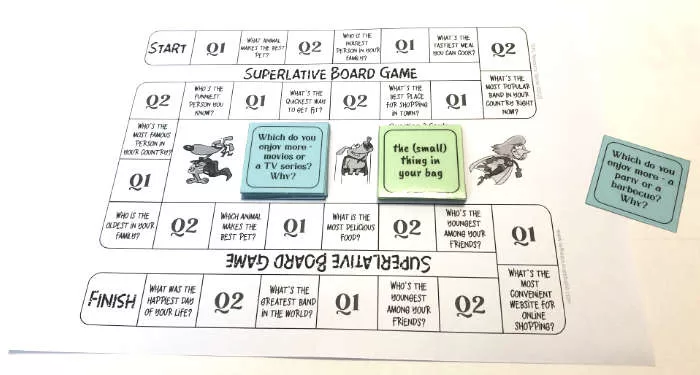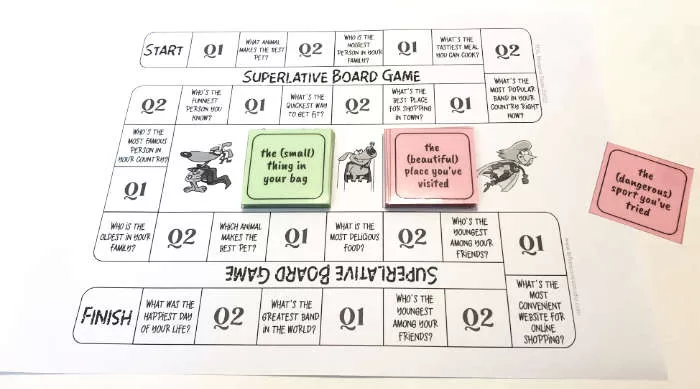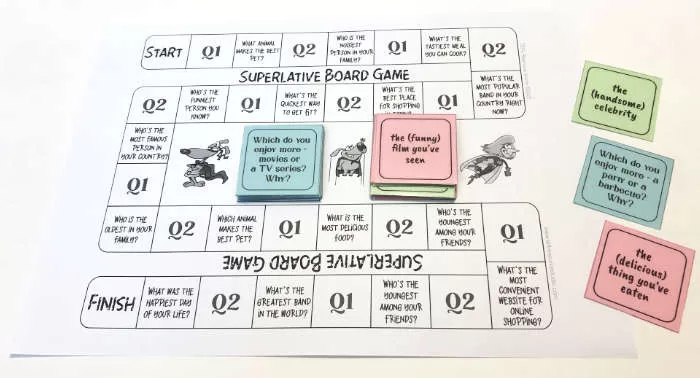What’s the need?
I’m about to teach a lesson on superlative adjectives, so I’m looking for a communicative board game that will be the right level for my elementary adult students. Most of the games I find also include practice for comparative adjectives, which I don’t want to focus on at this time. A few board games mix in the present perfect tense with questions like ‘What’s the most amazing place you have ever been to?’ We haven’t covered the present perfect tense yet, so those activities would be too difficult for my students. Eventually I give up looking and try to find a different type of activity to use. Perhaps this sounds familiar? However, for the past few years, I’ve been making my own board games. So, could I design my own?
Mixing different language
We often teach superlative adjectives with other language such as comparative adjectives. They also go nicely with the present perfect tense, and it would be great for students at higher levels to practice that. So, should I make 3 different board games? Or is there a way to make one board game be flexible enough for a variety of different teaching situations?
A board game just for superlatives

After a fair amount of trial and error, I eventually settled on a design with 16 question squares, space for two card decks (labelled Q1 and Q2), and 16 squares labelled either Q1 or Q2. The idea being that if you land on one of those squares you pick a card and make a sentence from the card prompt / answer the question on the card. This allows the teacher to have more control over the content, so it can be tailored to their class.

Next, I added a deck of 20 cards with speaking prompts. Split the deck in two and placing them on Q1 and Q2 spaces in the middle of the board (pictured). Now the board game is ready for students to practice using superlative adjectives.
Superlatives and comparatives

But what if I do want to practice both Comparatives and Superlatives together? My class next semester will likely need to do this. Well, in that case, we can just add another deck of cards. I already have a deck of cards the same size for practicing comparative adjectives. If I put them on Q1, I can move all the superlative cards to Q2. Now I have an activity for both comparatives and superlatives (see pic).
Superlatives with the present perfect (higher level)

I also have an intermediate level class, who need to practice superlatives. I think you see where this is going; I have a third card deck. The prompt on this deck requires the use of the present perfect tense together with a superlative adjective. This will be a bit more of a challenge, and therefore perfect for my intermediate class. I’ll place this deck on Q2 and the basic superlative deck on Q1, and we are good to go (see pic)
Everything all at once

If I wanted to review lots of different language together, I could even mix two decks together, and use all three decks with the board game at once (see pic). This would be a great activity for a review class to consolidate a variety of different language.
Card decks as separate activities
Two of the card decks I added to the board game were separate activities in their own right. And there is no reason why the third deck included with the board game couldn’t be used as a separate activity if one wanted.
The card decks can be used in two different ways. Firstly, as a mingle activity. Each student has a card and mingles around the classroom asking the question on their card to other students. Then students turn their card around so that it faces away from them, and continue to mingle. This time, the students ask a question based on the card belonging to the student facing them. This way students get practice asking a variety of questions.
A second way to use the card activities is to have students in groups. Students take it in turns to pick a card and form a question based on the prompt. They can either choose who they would like to ask the question to, or the teacher can instruct them to (for example) ask the person to their left. Students continue taking it in turns to ask a question until all of the cards have been exhausted.
How many combinations?
Depending on which card sets you use there are four different versions of the board game. Using the cards as separate activities, that makes a further 3 activities. So in total, the whole set gives you 7 activities that are sure to fit in to your teaching situation.
Where to get them?
You can get the basic board game here on my TPT store – it includes just the one deck of cards for practicing superlatives. The additional card decks are sold separately as they can be used as separate activities. However, I’ve put them together in a mini-bundle with a generous discount so you can get this flexible resource for an incredibly low price.
Want some ideas on how to use board games effectively in your ESL classroom? Check out our blog here.
Interested in other board games? Check out our gallery here. Alternatively, join our mailing list to keep up to date with new board games and other ESL teaching resources .
